 In today’s world, nurturing prospective students towards enrollment can be a taxing process. Potential applicants expect diligent follow-up at a number of different stages through a variety of channels, and with more inquiries to deal with than ever before, it can be difficult for schools to keep up.
In today’s world, nurturing prospective students towards enrollment can be a taxing process. Potential applicants expect diligent follow-up at a number of different stages through a variety of channels, and with more inquiries to deal with than ever before, it can be difficult for schools to keep up.
Marketing automation platforms like HubSpot, Mautic, Marketo and others can take the pain out of everyday marketing tasks, allowing your team to focus its attention on other things. Not only that, but it can allow your school to build personalized, dynamic, and streamlined student recruitment campaigns that can dramatically improve your conversion rate. Keep reading to find out how.

How CRM and Marketing Automation for Education Work Together
While they are technically separate functions, marketing automation and customer relationship management (CRM) often go hand in hand.
CRM platforms provide users with applications to help them design and manage their follow-up processes and workflows to create a more streamlined lead management system. When married with marketing automation, however, this functionality can be taken to a whole new level. Using the various capabilities an MA platform offers, your school can integrate automated marketing events which can be triggered at different stages throughout your CRM workflow processes.
One of the simplest examples of this would be an autoresponder mail, which can be automatically sent to a new prospective student as soon as they fill out a form to be entered into your CRM.
Example: This contact was automatically sent an initial response through Mautic after making an inquiry about a Business English program. As you can see from the top line, the system also tracks when the mail is read, and automatically changes the contact stage in the system. Your admissions team is able to view the full marketing automation event history for each individual contact.
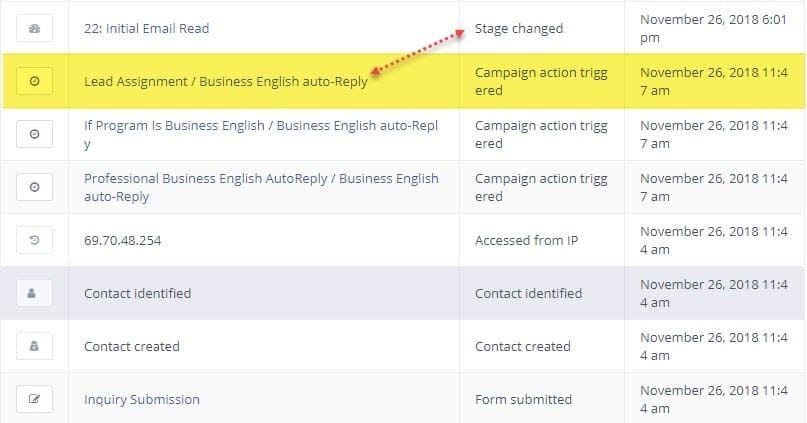
You can also update a lead’s status in your CRM workflows based on other behaviours, such as registering for or attending an event, or downloading a brochure or PDF file. From there, you can trigger various other actions as they move down the admissions funnel, utilizing email campaigns, SMS, instant messaging, and complementary content offers to ensure that each prospect is receiving regular, personalized follow-up.
This means you can scale your marketing operations to follow up with more leads in a shorter period of time and ensure your school is making contact with every prospective student at crucial touchpoints in the enrollment journey.
Creating Automated Email Marketing Campaigns for Schools
Email marketing campaigns are one of the most common and widely used features of marketing automation for student recruitment. By creating standard email templates, you can build workflows which will send automated mails to prospective students at specified times or stages in your process. Here are a few examples of different types of email campaigns you might consider for your school:
Email Lead Nurturing
An email lead nurturing campaign involves creating a series of mails which each touch on different aspects to your target persona’s motivations and concerns. These mails are then systematically rolled out by your marketing automaton system at regular intervals, gently encouraging prospective students to take the next step in the process.
Example: This email lead nurturing workflow from a business school cycles through nine messages on a more or less weekly basis. The sequence begins with an autoresponder, before touching on different subjects in each mail that might be of interest to potential applicants, such as the campus facilities, financing, and application tips.
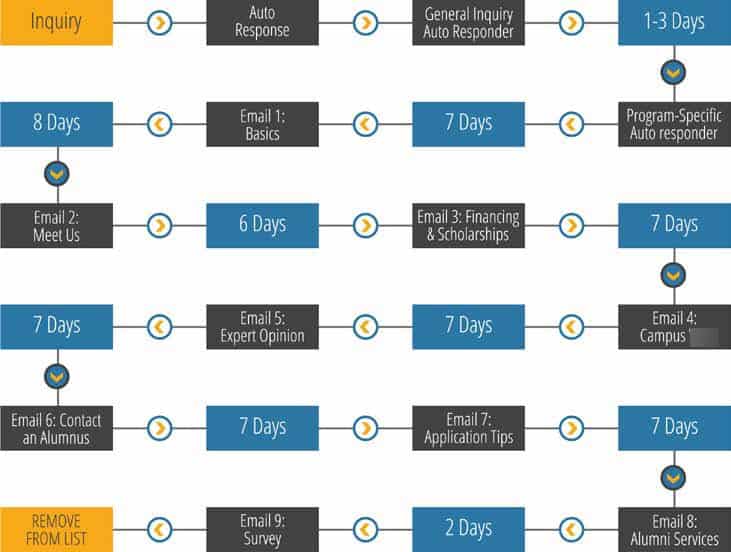
You can create nurturing campaigns for prospective students at different stages in the admissions lifecycle. The above, for instance, is mainly aimed at new inquiries, and focuses on providing an overall introduction to the school and its unique selling points. For prospects who have already made an application or scheduled an interview, you might take a different approach, focusing your mails more on the specific factors that make your school different from its competitors, overcoming final barriers to entry, and encouraging the recipients to contact you to answer any lingering questions they might have.
Events
Another powerful way to use automated email marketing is to promote events targeted towards prospective students, such as open houses, campus tours, and even online offerings like webinars. Using marketing automation software, you can create workflows which trigger event-specific messages.
This can be used to invite existing leads to your event, typically by sending around 3 separate emails. Typically, you should begin sending out email invites for on-campus events a few weeks before they happen, with the last mail going out about a week prior to the date. However, this timeline can depend on how far in advance your target audience will need to be aware of it in order to plan their attendance.
For online events, it can be better to begin your campaign closer to the date, usually about two weeks out. Because prospects can view it from anywhere, you can send a final reminder on the day of the event, to give them one last opportunity to sign up.
You should set your workflow up so that leads are automatically removed from it once they register, and placed in a separate workflow to provide reminder emails prior to the event, together with any pertinent details they might need such as directions, a program of activities, or login information for online offerings.
Example: A workflow for an online webinar. Note how registrants are transferred to a parallel workflow after signing up, which provides them with a confirmation mail, a reminder on the day, and a follow-up mail after the event.
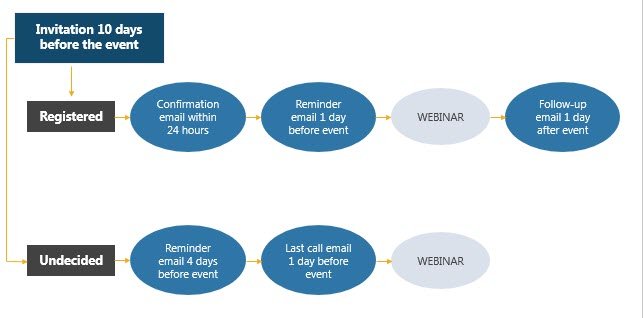
In all cases, you should include follow-up emails after the event. Prospective students who attend an event, whether in person or online, are indicating serious interest in your school, and may also have additional questions, so this is the ideal time to get in touch with them.
Newsletters
Student recruitment can be a long-term process. Many of your leads will begin researching possible education options long before they enroll. Students may need time to arrange their financing, complete exams, or prepare for moving or travelling abroad. As a result, institutions in some sectors will sometimes have leads in their system for several months or even a couple of years prior to them making an application.
In these situations, regular email newsletters can a be a great way to keep their interests fresh. You can use marketing automation software to send prospective students updates that are tailored to specific programs or groups, keeping your institution top of mind for when they are ready to move forward.
Example: Discovery Community College produce a regular newsletter which includes an array of content for prospective students, including blogs, quizzes and information about upcoming events.

While email nurturing can be very effective, keep in mind that it is best when paired with regular contact attempts through other channels, like phone, SMS, and instant messaging. Your school should work to build integrated workflows that allow your team to make frequent attempts to follow up with each prospect manually. With your emails doing the groundwork for you, you’ll stand a much better chance of success.
Example: A more complete workflow that covers follow-up across a range of channels.

Using Education Marketing Automation for Your Landing Pages and Lead Capture Forms
Many marketing automation platforms also provide the facility to create lead capture forms for your website. This allows you to build everything from inquiry forms, to newsletter signups, to applications, customizing each to your needs. Once a lead fills out a form, their details will automatically be imported into your CRM for schools.
Example: The initial event history for the previously shown contact in Mautic. Here, you can see that the prospect hit a landing page and submitted a form, after which a new lead was created in the system. An asset was also downloaded once the inquiry was submitted, and an autoresponder email was sent.
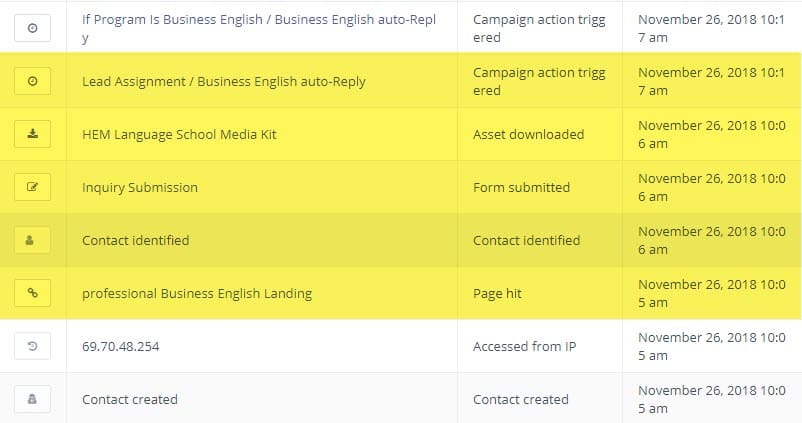
For best results, your team should carefully consider the fields it includes in each form you create. The aim should be to gather as much information as possible in order to better segment and assess each prospect, without overwhelming them with long and overly detailed forms.
Example: The form on this landing page from Lakefield College School obtains a lot of pertinent details without being overlong or complicated.

It may also be possible to create landing pages directly from your marketing automation platform. This option offers the advantage of simple template creations, easy integration of your forms, split testing and editing tools, and real-time analytics which can offer insight into engagement.
On Hubspot for example, you can view data on page views, submissions, and source channel, among other metrics.

Best of all, when linked to your CRM system, you can see the details of each and every lead who converts through your specific pages. Many marketing automation platforms will also offer tools for creating customized CTAs, buttons, and other types of dynamic content.
How Schools Can Use Marketing Automation Tools for Social Monitoring
Some marketing automation software for education also includes social media management and monitoring tools. HubSpot, for example, has a full social publishing suite that allows you to create and schedule posts across sites like Facebook, Twitter, and Instagram. This can be an amazing timesaver if your school wants to post about something specific across a number of different channels. You can draft all posts together at the same time in one centralized system, while still tailoring your content to the specific parameters and best practices of each social network. HubSpot also allows you to schedule posts in bulk, making it easier to plan your social media schedules and ensure you have a regular flow of activity on all your pages.
Example: The social post creation tool in HubSpot, which allows you to centrally create and schedule posts across a number of different social networks at once.
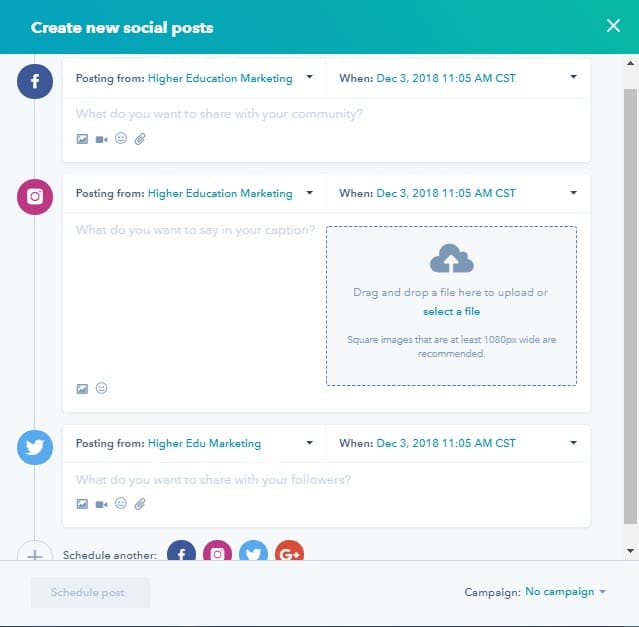
Social monitoring tools are also available. By linking your social accounts to your platform, you can track any engagement and comments on your posts centrally, allowing you to respond to prospective students in a timely manner.
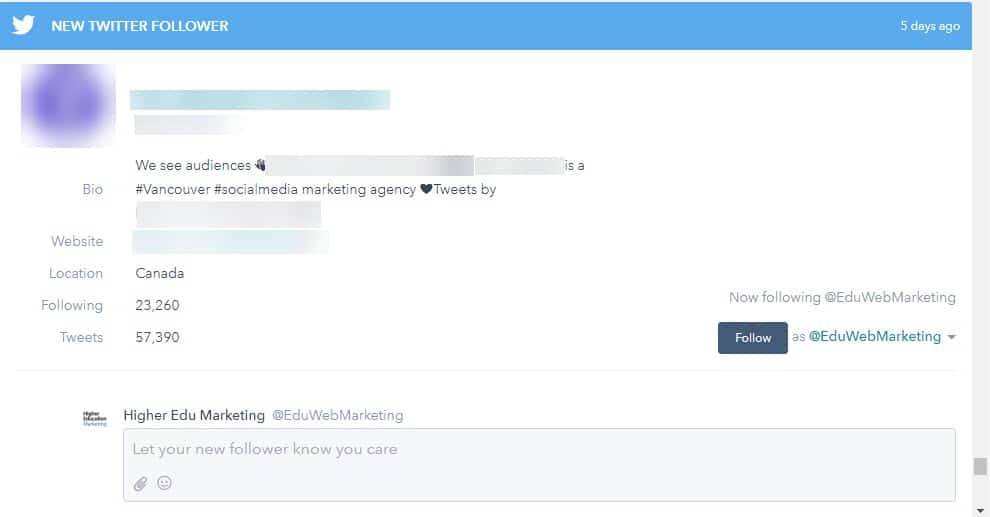
Additionally, many marketing automation systems allow you to track specific channels for mentions of your school. Mautic, for example, offers the option to track your Twitter handle or hashtags, so you can see how much traction your school is gaining on the site.

Developing a Student Lead Scoring System with Marketing Automation
Lead scoring can be a way to bring all of the above together in order to evaluate the quality of the prospective students you are attracting, and to measure how they progress throughout the enrollment journey.
Using a marketing automation platform, you can assign scores to certain activities and behaviours that will automatically update whenever a user completes a certain action, such as reading an email, downloading a brochure, or attending an online event.
Example: Here, a prospective student gains ten points in Mautic after reading an email.

This can be a great way to judge their level of interest in enrolling, and can help you prioritize your hottest prospects, and make contact with the right leads at the right time. For instance, you can trigger a user to be assigned to a particular workflow to receive a call from your admissions department once their score reaches a certain number.
Of course, not all leads are created equal, and you can also assign initial scores to delineate prospective students who you have confirmed meet key enrollment criteria or whose characteristics match up with your student personas.
Example: You might choose to assign an initial score to all prospective students inquiring from your main target locations.

At a more advanced level, negative lead scoring can be set up to help you identify prospects who indicate that their interest has cooled through activities like unsubscribing or disengaging from your emails. Additionally, score degradation can be put in place, so that leads who have not shown much interest in your institution in some time can be deprioritized in your workflows.
Accessing Data and Analytics on Your School’s Marketing Automation System
The best part of using marketing automation is that absolutely everything you do on your system can be tracked and measured. This means that you gain an abundance of additional data that can be used to measure the success of both your digital marketing and student conversion processes.
For a start, your system will give you a plethora of insights into your email marketing campaigns, allowing you to analyze open rates, click-through rates, and other metrics in order to determine the effectiveness of email content and drive continuous improvement.
Example: Some of the email analytics available in HubSpot. The platform also provides a click map of your mail, a summary of engagement over time, data about the time spent viewing a mail, and a list of your most engaged contacts.

You’ll also get similar metrics on things like landing pages, CTAs, and social posts with certain platforms.
What really makes this data different from other analytics sources is its depth. Because all actions are attributable to specific contacts in your system, you get to see what activities are driving your top-quality prospects to convert. Essentially, you can map the conversion path of your most high value prospects, and aim to replicate it in your future marketing efforts.
You can also analyze each of your channels to see not just which ones are generating leads, but which ones are most likely to attract prospects who actually end up enrolling in your school. This can help you to determine the value of different components of your digital marketing mix.
Example: A channel report in Mautic. From here, you can see that this school’s website and mobile paid advertising campaigns are its main drivers of lead generation.
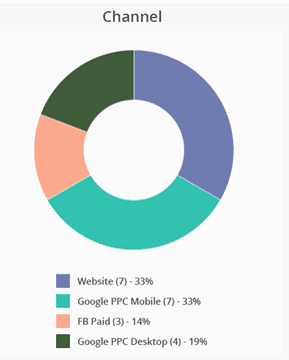
When used to its fullest potential, marketing automation can be one of the most valuable tools in your school’s arsenal, helping you to scale your student recruitment efforts and bringing order and cohesiveness to your campaigns. Once you’ve been using it for a while, you will wonder how you lived without it.






